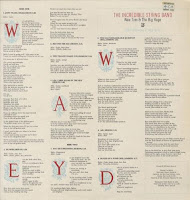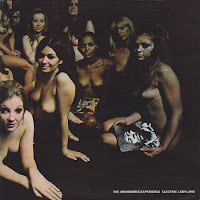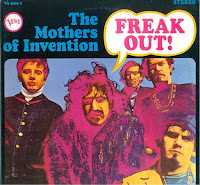Captain Beefheart and His Magic Band "Trout Mask Replica"
Pop's great leap forward. Taking account of the
innovations in songwriting made by The Beatles, particularly "Strawberry
Fields Forever", and Frank Zappa's exploration of formal composition and
juxtaposition, Captain Beefheart and his fellow musicians were the first to
tackle the form of pop music, to take apart the building blocks of the music
and put them together in a way different from anyone before.
This achievement was not recognised at the time. Critics
and fans were confused by scarcity of traditional musical moves and assumed
that the music was a melding of blues forms with free jazz. Subsequent study,
and the release of earlier recordings, demonstrate that there is
very little that is free about this music. Beefheart himself always referred to
these pieces as compositions and they are composed, albeit not in a traditional
style. Away from the myth (that the songs were composed in an 8 hour shift by
Beefheart on a piano after he had stared at it for a while) and the trappings of
Beefheart's own language (exploding note theory) is the even weirder story of
how half a dozen, starving beat musicians locked themselves away in a house and
over the course of 9 months invented the most startling pop music anyone had
heard to that point.
There are a number of different styles reflected across
the album. Some pieces are poetic narration, "China Pig" is a
straight forward blues, some pieces are sung in the style of field chants, "Moonlight on Vermont" is an early statement
of rock riffology. Far from unmelodic, the songs are chocked with melody.
Snippets of music taken from Beefheart's childhood, TV adverts, other pop songs,
and recognisable riffage all break out amidst the dissonance. Musical motifs and
phrases reoccur, sometimes played in unison, sometimes separately. The music
deploys serious musical concepts like counterpoint and polyrhythm in a playful
fashion and this, together with some of the jokier moments on the recording
made people think that the group were not serious. But this is deeply serious
music - people do not devote 9 months of their life, every waking day, and
forego all possible sources of earnings, for a series of jokes.
Each of the major compositions (major in terms of
significance rather than length or portentousness) can be broken down into
small chunks of repeated elements. These elements consist of a short musical
phrase played by each of the two lead guitars and the bass. Each phrase is
repeated, sometimes four times, sometimes more, and some phrases are repeated
again later in the composition. The difficulty that many listeners have with
this music is that each phrase played by each instrumentalist is usually
separate from that played by the others, both in terms of tempo and key. The
rules of musical harmony and rhythm are shattered. Each note has its own worth
and contains within itself the possibility to be followed by any other note
without concern for key or pitch (Beefheart's exploding note theory). What
stops the music from collapsing into chaos is that each phrase is the same length
for each instrumentalist. Thus they are able to start and stop at the same time
and it is this which made the music reproducable by performers who were not
conventional trained musicians able to sight read sheet music.
It is the job of the drummer to keep all this together,
to play out the length of each phrase and to accompany and emphasise some
elements of the musical parts and to contrast with others. The drummer
sometimes plays a conventional rhythm and sometimes plays polyrhythms. It is
the greatest drumming performance that I am aware of in pop music. Even more
extraordinary is the fact that it was the drummer (whose name is John French)
who transcribed the musical parts for the other musicians to play as well as
transcribing his own drum parts to the extent that he would later record an lp
consisting of just the drum parts for some of these songs (just the drums, no
other instruments, and an amazing listen it is too).
Fittingly considering the musical accompaniment, the
lyrics for the compositions on "Trout Mask Replica" are unlike
anything else up to that point. The subject matter of some of the songs
is sometimes the usual material of pop music - feeling happy, girls, but it is
handled elliptically. Other subjects addressed include the holocaust, man's
relationship with nature, a comparison between how men and ants fight amongst
themselves over small things while bees are able to share, how societies
establish themselves and develop.
The language used and sentence constructs are closer to poetry
than conventional pop lyrics. Phrases are repeated but there are no choruses,
again fitting with the dislocated nature of the music. Unusual words like
"hominy" (coarsely ground corn), "gingham",
"faucet", "atomiser", "bobbin", "floozy",
"speidel" (a brand of watch), "Merc Montclair" (a type of
car) signify an older America. And these words are not accidental, several of
them occurring more than once in different songs. Birds, ants, bees, worms, a
fly, butterflies, fish, a jack rabbit, a horse, bears, wild geese, swans, mice,
gophers, alligators, and a white elephant are all mentioned, sometimes recurring in different songs. This may be the most animalistic lp of all
time. Characters such as hobbos, bums, old women, mothers, fathers, daughters,
Lousey, Big Joan, Ella Guru, Mrs Wooten and Little Nitty, Ole Gray, and Bimbo
Limbo Spam all appear. The ocean, the sea, the sky, the sun, and the moon are
referenced repeatedly.
Did Frank Zappa ruin "Trout Mask Replica"?
Frank Zappa produced the lp and left us with a fairly muddy sound. The drums in
particular lack oomph. The vocals are pushed to the front of the sound, along
with the horn parts, leaving the band relegated to the background for many
pieces. Zappa interposes himself on some parts of the album with interjections
and one song directed to himself ("it's the Blimp, Frank") which
features a recording of his own group rather than The Magic Band. His other
significant double album production of this time by an artist other than
himself was his overseeing of "An Evening with Wild Man Fischer", a
recording of a local eccentric/mentally damaged person. Along with his
production of The GTOs (an album made by groupie hangers on), was Zappa
cultivating a stable of freakish outsiders and harnessing them for cheap laughs
and did he see Beefheart and his music as another example of this? It is a
point worth considering.
However, it should be recognised that possibly only Zappa
had the willingness and the means to produce a record by Beefheart at this
point in Beefheart's career. Beefheart had fallen out with his record company
over their post-production ruination (as he saw it) of his previous lp, the
blues and psychedelia driven "Strictly Personal". Beefheart had also
wanted to put out a double lp, "It Comes To You in a Plain Brown
Wrapper", comprising these recordings and the longer pieces subsequently
released as "Mirror Man". Beefheart always saw himself, rightly, as
an Important Artist, and probably felt he should be allowed to make a major
statement like The Beatles or Jimi Hendrix had done with their double albums.
Zappa not only agreed to record and release a new Beefheart lp but also to make
it a double album, thus satisfying Beefheart's ego. As with the Wild Man
Fischer and GTOs lps, there can only have been a limited financial incentive
for Zappa to do this. None of these were conventionally commercial
propositions. Zappa also produced all these lps at a time of great creative
endeavour for himself and his own output. It seems unikely that he would have
diverted his efforts into these channels unless he thought there was something
more meaningful that could be uncovered.
However, it is also the case that producing these three
lps did not involve Zappa in too much work. Both Wild Man Fischer and Beefheart
often perform unaccompanied necessitating little effort from any producer and their lps include non-studio recordings.
"Trout Mask Replica" includes what are clear one-take errors (such as
Beefheart being unable to get all of the words into "She's Too Much For My
Mirror") which were not subsequently corrected. Beefheart's next lp,
"Lick My Decals Off, Baby", has a much clearer production than
"Trout Mask Replica" with a greater separation and differentiation of
the various instruments. However, not all of this is Zappa's fault. He appears
to have been taken aback by the Magic Band's ability to play their pieces
straight through in one take. They were so well drilled and used to playing as
a collective that they may not have been able to play their individual parts
separately to facilitate separation of the instruments. John French
played at least one of the songs on the album with cardboard covering his drums
and cymbals, which cannot have helped with getting a good drum sound (nor with
playing the instrument). Beefheart himself had not bothered rehearsing with the
band so no-one (including him) knew where the vocal parts would fit with the
music. It is alleged that he recorded his vocal and saxophone parts without
headphones so he could not even hear much of the music. And doubtless Beefheart himself insisted that his performance should be to the fore.
The mixture of sources used for the lp does give
"Trout Mask Replica" variation across the four sides but not always
satisfactorily. "Moonlight on Vermont" and "Veteran's Day
Poppy" are sensational recordings but jar with their surroundings. Some of
the album was recorded at The Magic Band's house rather than in a studio ("a bush
recording" as Beefheart has it) and being interupted by their new neighbours.
"China Pig", a spontaneous recording, sounds like it was recorded on
a cassette player with a former member of the group and his straight blues
playing does not fit with the more advanced material elsewhere on the record.
The vocals for "The Blimp" are dialled in, literally being recorded
over the phone, and then played back over a recording of Zappa's Mothers of
Invention. And then there are the occasional bants between Beefheart and the musicians. All of these are mere
trappings. Entertaining in their own right, they can detract from the main meat
of The Magic Band recordings at Whitney Studios in March 1969. The result is
that sometimes "Trout Mask Replica" is dismissed as freaky outsider
music that is cool because it is so far out. Rather than the album be
recognised as a major art statement and art achievement of the later 20th
century. Nobody knows what is going to happen in the future but few would be
surprised, I think, to discover musicians in 22nd century conservatoires still
trying to unpick exactly what is occurring in these recordings and to attempt
to reproduce them. Good luck with that, everybody.
 The live lp has four songs from Pink Floyd's repertoire
at the time. All are well recorded and feature powerful performances that are
surprisingly muscular and represent the peak recordings of Pink Floyd's career
as space rock voyagers. The group show a good sense of dynamics; building and
dismantling and rebuilding pieces in performance. All of the songs played are
considerably expanded from their original studio recordings and feature clever
abstract sections that do not sink into the sort of free jamming that something
like The Grateful Dead's abstract "Feedback" section did.
The live lp has four songs from Pink Floyd's repertoire
at the time. All are well recorded and feature powerful performances that are
surprisingly muscular and represent the peak recordings of Pink Floyd's career
as space rock voyagers. The group show a good sense of dynamics; building and
dismantling and rebuilding pieces in performance. All of the songs played are
considerably expanded from their original studio recordings and feature clever
abstract sections that do not sink into the sort of free jamming that something
like The Grateful Dead's abstract "Feedback" section did. 











